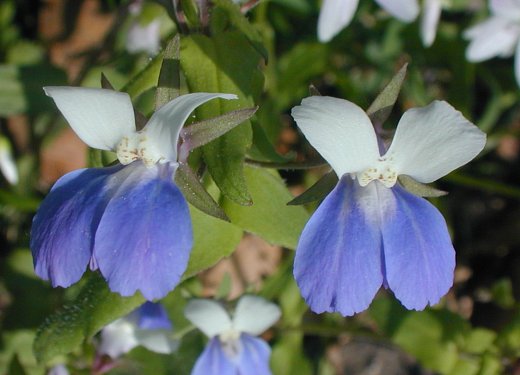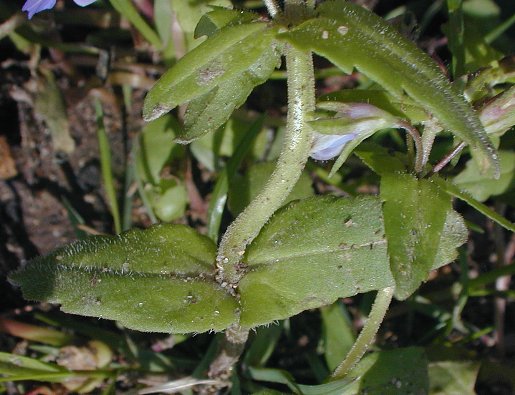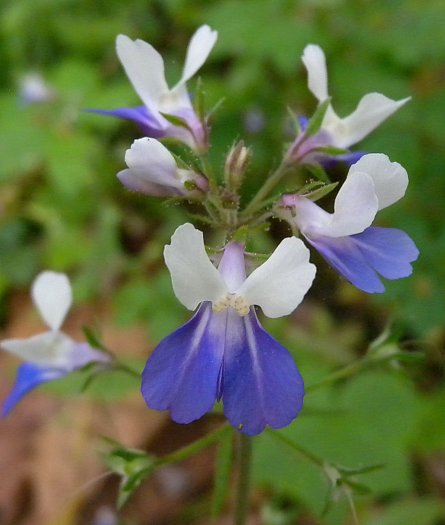Description: This wildflower is a winter annual about 4-12" tall that is unbranched. The central stem is light green, terete, and pubescent. The opposite leaves are up to 2" long and ¾" across; they are either medium green or yellowish green and either glabrous or pubescent (usually the latter). The lowest leaves are oval to orbicular with a few blunt teeth along their margins; they are smaller than the other leaves and there are petioles at their bases. The middle leaves are the largest and most conspicuous; they are oval to broadly lanceolate, often with a few blunt teeth along their margins, and their bases are either sessile or they clasp the stem. The uppermost leaves are usually lanceolate and smooth along their margins; their bases are either sessile or they clasp the stem.

The central stem terminates in a whorl of 2-6 flowers on slender pedicels up to 1" long. Sometimes individual flowers develop from the axils of the upper leaves as well; these axillary flowers have slender pedicels up to 1½" long. The pedicels are light green, terete, and pubescent. Each flower is ½-¾" across, consisting of a green calyx with 5 teeth and a blue/white corolla. The calyx is light green to purplish green; it is often pubescent and its teeth are narrowly triangular in shape. The corolla is short-tubular and it is divided into upper and lower lips. The upper lip is cleft into 2 large rounded lobes that are white, while the lower lip is cleft into 3 lobes. The 2 large outer lobes of the lower lip are light blue to blue-violet and rounded, while the tiny middle lobe of the lower lip is folded into a keel and hidden from view. This middle lobe contains the stamens and style of the flower.

The
blooming period occurs from mid- to late spring, lasting about 3
weeks. Afterwards, each flower is replaced by an globoid-ovoid capsule
that contains a few large seeds. The root system consists of a slender
taproot. This plant spreads by reseeding itself; it often forms
colonies of variable size.
Cultivation:
The preference is dappled sunlight to light shade, moist to mesic
conditions, and a rich loamy soil. The size of individual plants is
strongly influenced by moisture conditions and the fertility of the
soil. The seeds should be planted during the summer so that they will
germinate during the fall.

Range &
Habitat:
Blue-Eyed Mary occurs occasionally in NE and east central Illinois, but
it tends to be less common elsewhere (see Distribution
Map). At some high quality sites around the state, it is
locally abundant. Habitats include moist to mesic deciduous woodlands,
wooded lower slopes of river valleys, and areas along woodland paths.
Sometimes Blue-Eyed Mary occurs in drier deciduous woodlands, in which
case the individual plants will be smaller in size. Even though it
tolerates minor levels of disturbance, this wildflower is an indicator
species of high quality woodlands.
Faunal Associations: The
nectar and pollen of the flowers attract honeybees, bumblebees, little
carpenter bees (Ceratina
spp.), long-horned bees (Synhalonia
spp.), and mason bees (Osmia
spp.). Less common flower visitors include dance flies (Empis spp.), the
Giant Bee Fly (Bombylius
major), butterflies, and skippers. Little else appears to
be known about floral-faunal relationships for this species.

Photographic
Location:
Along a path in a deciduous woodlands at Allerton Park in
Piatt County, Illinois, and the wooded lower slope of a river valley at
Lodge Park in the same county.
Comments:
The distinctive bicolored flowers are very beautiful,
making Blue-Eyed Mary easy to identify. This woodland
wildflower is unusual in having flowers that are close to a true blue
color. The only other species in the genus that has been observed in
Illinois is Collinsia violacea
(Violet Collinsia). This latter wildflower is also a winter annual that
has corollas with a deeper shade of purplish violet and more narrow
lanceolate leaves. Violet Collinsia prefers sunnier habitats than
Blue-Eyed Mary, and it is quite rare within the state, although more
common in the Southern Plains region of the United States.